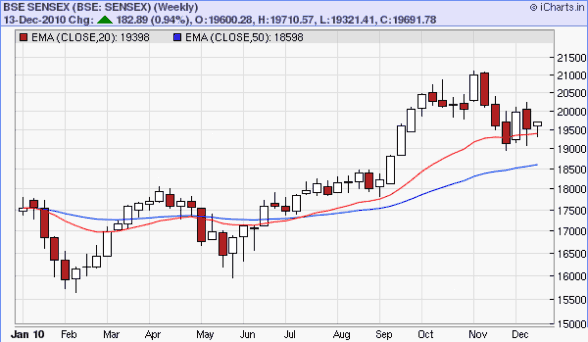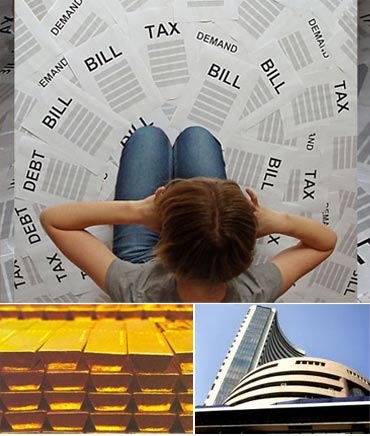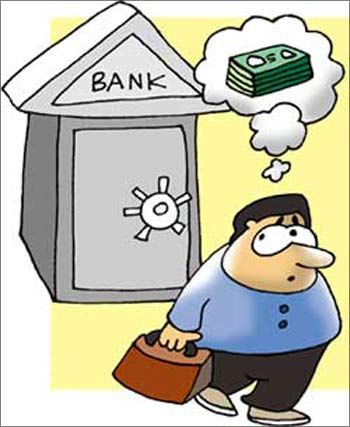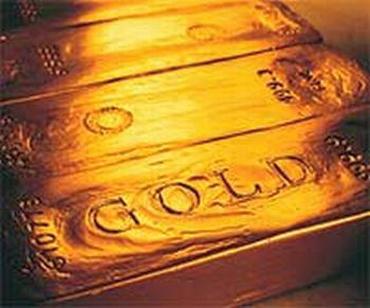Photographs: Rediff Archives Anil Rego
What a year it was!
The past year turned out to be roller-coaster ride for all, the host of regulatory changes arguably leading to greater transparency in the investment world -- the world of mutual funds look very different to what it looked like last year; ULIPs underwent multiple makeover sessions, PMS service guidelines were chalked out with greater clarity, etc.
On the policy the cabinet, with very few surprises, including the delay in its implementation, passed the direct tax code!
During the festive season a couple of months ago, equity markets scaled highs that were once seen during early 2008, but it didn't last long, as scams / negative news started stumbling out of the closet and sentiments remained cautious.
Even then asset markets, particularly equities, continued to trade with a bullish undertone. FIIs invested heavily during the year and corresponding cash inflows continued throughout the year with India hogging limelight in the region making it amongst the best performing emerging markets in the world.
On the debt front, RBI hiked rates at every quarterly review meet in the past year except the most recent one. This however has failed to take the street by surprise and the outlook remains that this trend of rate hike is likely to continue over the next two quarters, with the intention of taming inflation.
Gold remained buoyant amidst various countries declaring sovereign debt crises, the metal continues to get expensive by the day.
But is that a bubble? That's the prime question many investors would love to find an answer for in the New Year.
Here's a roundup on how various asset classes panned out for investors over 2010 and a look at how they look like in the New Year.
Equity markets
Markets had a generally good run over the last year; starting @ 17,473 levels, over the first quarter, the debt crisis in the PIGS (Portugal, Ireland, Greece and Spain) countries dragged the Sensex all the way to 15,900 levels.
The change started with corporate earnings in Q1 lifting the spirits of the markets; however it continued to remain range-bound till August 2010. Q2 results were the game changer with the markets being propelled into a new trading range above 18k levels.
On Diwali, markets touched the all time high of 21,108 -- a level that was only once seen in early 2008.
In November 2010 and December 2010 the 2G scam, CWG scam, housing finance scam and insider-trading scam in India took its toll over investor sentiment. The rally got subdued after a while and it has fallen back to 20,000 levels.
Outlook for 2011
First half of 2011 will in all probability extend the volatility seen in recent weeks on the back of mixed Q3 results likely to come out after mid-January.
With inflation data refusing the show signs of softening, we expect continued pressure on the corporate segment and pressure on net margins. Funds flows should continue to come into the Indian markets given the lack of meaningful investment avenues for the developed market-based money managers, though we don't expect a repeat of 2010 in terms of quantum.
Continued volatility in the equities market would mean there would be ample opportunities to trade and make money and invest in stock which you might have missed out in 2010; though timing could play a critical part in taking exposure in the same.
Sectors such as IT (large cap), pharma and infrastructure (including power) should be in favour while banking, autos and cyclicals could see some pressure.

Debt markets
The Indian bond market has seen some serious battering for the last one year with benchmark G-sec yields rising from 7.45 per cent, after the scare of sovereign debt default from European countries in May 2010, to over 8 per cent currently.
With the RBI generally inclined to higher interest rates, the debt market is poised to provide best in class returns in the coming year. Term deposit rates have already started rising slowly and with inflation still remaining a concern, clearly the rate hike regime is likely to continue and should benefit the debt investor over the next 12 months.
Banks in India have switched to the base rate system from benchmark prime lending rate (BPLR) system from July 1, 2010. Base rate includes all those elements of the lending rates that are common across all categories of borrowers. Banks may choose any benchmark to arrive at the base rate for a specific tenor that may be disclosed transparently.
The Reserve Bank of India's has finally discouraged the concept of teaser rates from the country's home loan market. Housing loan rates varies between 8 per cent fixed to 11 per cent fixed and the floating rate is 9-9.5 per cent after the RBI announced it's take on teaser rates.
Outlook for 2011
Bonds performed miserably on the back of rising money supply and resultant inflation and crowding out of private investment by the government, however, this year, it is all set to deliver the best on the table. Debt instruments are likely to outperform most other asset classes, as the effect of rate hikes will pan out over the coming quarters.
Move towards base lending rate is a positive trigger for borrowers, the interest charged will now be inline with the base rate and thereby any revisions in the larger landscape will be passed on to the borrower.

Bullion markets
Gold is believed to be a hedge against inflation and with most economies going bust during the past year it did not come as a surprise to many that the yellow metal continued its upward run. Gold clocked over 25 per cent on a year-to-year basis (since January 2010), and has been on a sort of joy ride with few glitches.
The scene continues to look bullish for the coming year, with various economies still facing the ripple effects of the recessionary times.
Outlook
Gold could witness consolidation with increase in volatility, quite unlike what we have seen so far. And on the back of mixed news from Euro land and the US, we could witness measures pushing for stability as well as larger risk to contagion on the larger economies in Europe.
However, the first half could see gold move northwards and depending on how things pan out subsequently across various economies, it could see a directional change.
The year ahead...
The fact that 2011 could be yet another year of consolidation, major events and volatility in the asset markets (at least in the first half) means that we could see investors, intermediaries and regulators on their toes as they have been in the second half of 2010. Yet 2011 could not turn out as a mirror image as far as asset performance is concerned. 2011 could well go down as the year of the debt investor and as for equities -- the bull-run usually is succeeded by a sustained bond rally and 2012 could be that year.
Hope it turns out to be fruitful year for you with multiple opportunities for wealth creation! Here's wishing all our readers, a Happy and prosperous New Year!






Comment
article